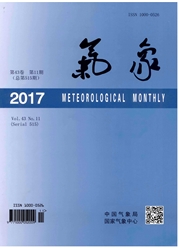

 中文摘要:
中文摘要:
利用集合经验模态分解(EEMD)方法研究了南京地区夏季高温日数主要的非平稳年际变化周期型。对1946—2000年的南京地区夏季高温日数进行分解,分别得到包含有准2年周期分量和6年周期分量的年际变化型,而且准2年周期分量幅度较大,变化特征与高温日数观测数据变化具有较高的相似性。不同于传统方法,EEMD方法给出了高温日数在不同时间尺度上各自分离的变化特征。另外,这两种时间变化模态的演变对应于同期夏季不同的全球200 hPa经向风波列型,前者主要作用区域在南亚经过南海、西太平洋的副热带地区到日本海附近、北美中纬度地区和南印度洋和南大西洋中高纬度地区,而后者仅位于欧亚中高纬度地区。这两种独立变化时间模态的对应的遥相关空间分布型对于提高南京地区高温日数气候预报精度有重要意义。
 英文摘要:
英文摘要:
Ensemble empirical mode decomposition(EEMD) method was adopted to study the non-stationary interannual variations of the high temperature days in Nanjing summer.Using the EEMD method,the days of the high temperature in Nanjing during 55 years(1946—2000) can be decomposed into a series of modes,including a quasi-biennial oscillation(QBO) component and a 6-year component.Among those, the QBO with the larger amplitude has the high correlations with original numbers of the,high temperature. In brief,the EEMD method other than the traditional and conventional methods can bring us the isolated characteristics of variations of high temperature days at various time scales for the interannual timescale.Moreover,the above two modes correspond to the different wave trains of the global meridional wind at 200 hPa.The former is over South Asia,the South China Sea,the subtropical western Pacific and the Sea of Japan,the middle latitude of North America,and the high and middle latitudes of the southern Indian and southern Atlantic Ocean,while the latter is over the high and middle latitudes of Eurasia. These relationships are of indicative guidance for the climatic prediction of the high temperature days in Nanjing.
 同期刊论文项目
同期刊论文项目
 同项目期刊论文
同项目期刊论文
 期刊信息
期刊信息
